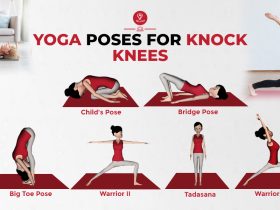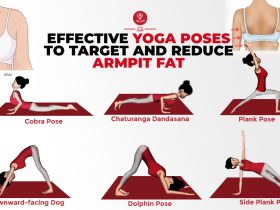
The human body is able to stand with the help of the backbone. Due to some reason or the other in this spinal cord, many types of disparities come and these disparities are known as scoliosis, kyphosis and lordosis. However, Lordosis is normal to a certain degree of extent. Poses of yoga for Lordosis may help in improving the ability to perform activities with ease.
In scoliosis, the spine becomes curved and it is often seen in the shoulders and hips. Kyphosis, which occurs in the upper back, often occurs in older women. In lordosis, the spinal cord curves forward in the lower part of the back.
The appropriate poses can be used to bring lumbar lordosis into balance and alignment.
Yoga for Lordosis Alignment
The risk of developing lordosis can be reduced by regular practice of certain yoga asanas. By doing yoga exercise daily, the muscles become active, strong and flexible. A conservative yoga therapy may get relief in lordosis to some extent.
Standing forward bend (Uttanasana)
Benefits: Uttanasana helps to stretches the spine and strengthens the back muscles. This will reduces the risk of lordosis. It also pressure off your lower back that gives you a nice stretch.
Stand up straight in Tadasana. Exhale and while bending forward, place the palms on the ground near the ankles. Do not allow the knees to bend, in the final position, point the head upwards without touching the knees. The spine will also remain erect. Take deep breaths in this action. Now exhale again and keep the head close to the knees. Breathe naturally, hold for about 1 minute or so. Now raise your head first, with a breath. Raise your hands and come back to the original position.
Seated forward bend (Paschimottanasana)
Benefits: Paschimottanasana provides a deep stretch for the entire backward part of the body from the heels to the neck, hence making the spine strong and flexible. It also stretches the spine, shoulders, lower back, ovaries, uterus and hamstrings.
Sit on the ground and straighten the legs in front. Exhale, while bending forward, try to give the toes of both the toes in the fingers of both the hands, keep the legs stretched. Don’t let the putts rise. Now slowly touch the head with the knees. After practice, the back does not remain raised, but becomes flat. Practice gradually, do not rush.
Plow pose (Halasana)
Benefits: Halasana can be therapeutic for management of lordosis spinal deformity. This asana also strengthens the backbone and neck muscles.
Lie straight on your back. Keep the arms straight on the ground beside the back. While breathing in, lift both the legs and bring them in “Ardha-Halasana”, support the back with both the hands keeping the elbows on the ground. Take 1-2 breaths in and out in this posture and make sure that your balance is correct. Now take the legs all the way back. Keep the eye on the nose. If you find it difficult to maintain balance, then you can also keep the vision on the navel. There is enough flexibility in the shoulders, then take the hands back and join them. If this is not possible, then keep them in the posture supporting the back. Stay in this posture for 60 to 90 seconds according to your ability and then slowly bring the legs back. Take a short time in the beginning (30 seconds is also enough) and gradually increase the time.
Cobra pose (Bhujangasana)
Benefits: Bhujangasana yoga strengthens your back muscles. It is also the best way to reduce back problems. If you follow the directions carefully, you’ll strengthen the pelvic muscles, as well as the muscles in your lower abdomen involved in sciatica.
Lie on the ground on your stomach and raise your neck and face towards the sky with your hands on the ground and the ankles of your feet should meet together. Put the weight of the body on the palms and elbows bent and the head going towards the back. The shoulders should be away from the ears. And the body should be taut. Relax your body by doing this for 15 to 20 seconds and then do it again. You can do this 5 to 6 times.
Locust pose (Salabhasana)
Benefits: Locust pose increases flexibility and strength to the spine which can reduce the degree of curve in the spine. Increases blood supply to the spine. Tones the muscles of the back, shoulders, neck and buttocks.
Lie on your stomach, palms and arms should be straight. Keep your chin on the mat. Inhale and lift head, chest and hands off the floor. Keep your arms straight behind you. Connect your legs so that your knees can easily lift off the floor. Keep your gaze down so that your neck remains in a neutral position. Breathe in this posture three to five times. On exhalation, drop the body down to the floor.
Cat Cow Pose (Marjariasana)
Benefits: This pose is a backbend stretch that targets the spine and abdomen and allows for flexion and extension, it involves moving the spine from a circular position to an arch position. It probably also helps you to become familiar with your neutral spine.
To do cat-cow pose, in tabletop position, slowly move from child’s pose on all four sides. Keep your wrists under your shoulders and your knees under your hips. Keep your back and neck straight and look down, balancing your weight evenly between all four points. Inhale and look up, pushing your shoulders further away from your ears. Pull your navel in and keep your abdominal muscles close to your spine. Now exhale and lower your head, keeping your chin towards your chest and your tailbone towards the yoga mat. Continue this flow for at least one minute.
Legs up the wall pose (Viparita karani)
Benefits: Viparita Karani asana gives relief from mild back pain. By doing this asana, the back and spine are flexible and make the spine strong. By doing this asana, the flow of blood in the varicose veins of the legs becomes smooth.
Spread the blanket about 3 inches from the wall. Extend your legs towards the wall and sit on the blanket. Lie on the blanket by bending the upper part of the body back. In this position, both the feet should be towards the wall. Keep the arms on the ground at some distance from the body. In this position, keep the palms facing upwards. Remain in this posture for 5 to 15 minutes. Bend the knees and turn to the right and then sit back in the normal position.
Conclusion
The effects of yoga movement associated with lordosis have been found to be more effective than conservative treatment for improving function and angle of curvature in the back.
RELATED ARTICLES
May 20, 2025
Kegel Exercises: Strengthen Your Pelvic Floor for Better Health
Kegel exercises strengthen the pelvic floor muscles, which support the uterus, bladder, small intestine and rectum. Strengthening these muscles improves[...]
Oct 06, 2024
Balance Your Body: Yoga Poses For Knock Knees (Genu Valgum)
Knock knees, or “genu valgum,” is a condition in which the knees touch each other while the ankles remain apart.[...]
Sep 20, 2024
Effective Yoga Poses to Target and Reduce Armpit Fat
Fat accumulation under the arms is a common problem for many women, which is often considered an important part of[...]
RECENT POSTS
Disclaimer
The content is purely informative and educational in nature and should not be construed as medical advice. Please use the content only in consultation with an appropriate certified medical or healthcare professional






